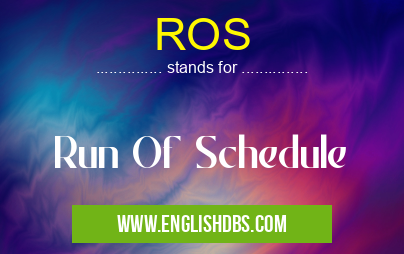What does ROS mean in GENERAL
ROS is a commonly used abbreviation which stands for Run Of Schedule. It is most often heard in the business world as it describes an advertising or promotional strategy which involves booking advertisement space at specified intervals or ‘runs’ and without any targeted audience. In other words, ROS campaigns focus on general market coverage instead of custom targeting.

ROS meaning in General in Business
ROS mostly used in an acronym General in Category Business that means Run Of Schedule
Shorthand: ROS,
Full Form: Run Of Schedule
For more information of "Run Of Schedule", see the section below.
Benefits of using ROS
Despite its limitations, there are many advantages of using an ROS campaign for advertising purposes. Firstly, they can be tailored to personal budget constraints since they aren't dependent on customer demographics like more expensive targeted campaigns. Secondly, because the runs take up fewer resources than traditional campaigns, they can be completed in shorter timescales. Lastly, unlike online activities such as pay-per-click (PPC) adverts, ROS campaigns have greater longevity; since such ads run indefinitely until the schedule changes or until the end of a contract period – thus providing longer brand recognition at lower costs to businesses.
Essential Questions and Answers on Run Of Schedule in "BUSINESS»GENERALBUS"
What is a Run of Schedule?
A Run of Schedule (ROS) is an advertising strategy wherein a number of ads are grouped together and run in multiple locations for a specified time period. It is typically used by companies to reach maximum exposure for their product or service.
How does a Run of Schedule work?
A ROS involves placing the same advertisement in multiple locations, such as on television, radio, print media, or online. This allows companies to reach many potential customers at once and maximize their exposure to the target market.
What are the advantages of using a ROS?
Using a Run of Schedule allows companies to save money by running one ad that can be seen in multiple locations, and also allows them to track the success of the ad by measuring how oftenthe ad was viewed or heard. Additionally, it enables them to build brand recognition as well as create awareness for their product or service.
How do I decide which media outlets to use with my ROS?
When deciding which media outlets to use with your ROS, consider what kind of audience you are trying to reach; if you're targeting young adults, for example, then you may want to focus your campaign on television channels they watch or websites they visit most often. Once you have determined where your target market resides, choose outlets that align with those demographics accordingly.
Are there any risks associated with running a ROS?
One risk associated with running a ROS is over-saturating your target market with too many ads; this could cause people to become fatigued and immune from responding positively towards campaigns from that company in the future. Additionally, running too many ads could lead to decreased effectiveness due to poor response rates due customer fatigue. It's important to strike the right balance when planning an effective ROS campaign!
How do I ensure my ad stands out during my ROS campaign?
Creating an eye-catching advertisement and incorporating interesting visuals will help draw attention during your ROS campaign and make sure it stands out from other advertisements. Additionally, make sure that key information such as contact details or special offers are clearly visible so viewers can easily take action after seeing the ad.
How long should my campaign last?
The duration of your campaign should depend on several factors including budget constraints and desired goals; typically speaking however it’s best practice to keep campaigns running between 2–4 weeks so viewers become familiar with your ad but don’t grow tired when seeing it repeatedly over longer periods of time.
Should I use different versions of my ad over my campaign duration?
Yes! Utilizing different versions of an ad throughout the course of an ROS campaign ensures viewers see something new each time as opposed to getting bored and tuning out altogether; if possible try mixing up things like visuals, text copy and tone based on who you’re tryingto target with each version - this helps keep potential customers engaged throughout!
Final Words:
In conclusion, the acronym “ROS” stands for Run Of Schedule and refers to an advertising strategy which involves booking advertisement slots across multiple outlets without focusing on any particular demographic or audience segmentation for maximum coverage efficiency. While this type of campaign doesn't necessarily bring about the highest ROI possible due to its lack of precise targeting capabilities, it has been shown to offer quick returns at low cost with sustained brand recognition over time – making it suitable for businesses with tight budget constraints.
